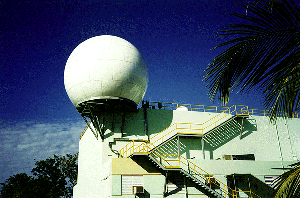

Mission Status Report #20 Star Date: October 1, 1999 NOTE: Mission Status Reports on the web page will continue roughly once a week, as events unfold. 

The Satellite Control Center at JHU (left) and a view of the FUSE ground station in Puerto Rico (right). (Click either image to see larger version.)
IDS Code Reload and Recovery ReportAfter weeks of careful testing of modified computer code for the instrument computer (the Instrument Data System, or IDS) by our colleagues at JHU/APL, we have spent this week uploading and testing this new code on the REAL THING (that is, the FUSE satellite itself). All signs point to a successful reload of the system, and an improved onboard capability for the satellite. This success was not achieved without difficulty, however, as you will read below. To minimize the "down time," we had scheduled extra commanding time through the TDRS satellite system (the same system used by the Space Shuttle and many other satellites to get data up to and down from orbit). We had planned on Monday and Tuesday for the code load and recovery, with Wednesday held as contingency. Well, it turned out that we had problems communicating through TDRS (as did other satellites--it was not a FUSE-specific problem), and we got behind schedule. The longer down time left us without thermal control for longer than expected, and so recovery was slowed by the need to adjust temperatures back to operational levels. Then, our Puerto Rico ground station went on the blink unexpectedly (for reasons that are being studied), which pushed things back even further! At this writing, we need a few more contacts with the satellite to finish getting back to a full operational condition, and we are set to pick up on the timeline again this evening for the weekend. The ground station situation is being worked very hard. Puerto Rico was rock solid over the last three weeks, after having some problems earlier. In some ways, the current problems are similar to the previous ones, but it looks like there could be more than one thing wrong, which complicates the process of diagnosis. In the mean time, we are buying commercial passes through the Universal Spacenet antenna in Hawaii. There is some good news on the "science" front: we have actually scheduled observations of a few select science targets "in the gaps" last week and weekend (prior to the IDS code load). Since we are not fully focussed and aligned yet (see last week's report), there are only certain observations that make sense at this point, that is, those that do not require high spectral resolution and are bright enough to be observed with only one or two of the four mirrors. But we have made some science observations and the team is working hard on these early data sets to see not only what they can tell us about how FUSE is performing, but also what they can tell us about the objects being observed! As we pick up now after the break in the schedule experienced this week, we will cotinue to intersperse science observations with on-going checkout activities as we tweak FUSE into its final operational configuration.
Reported by: Bill Blair, Chief of Mission Planning
|